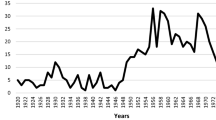Abstract
In this paper, we look at the way the state has helped shape the climate for the commercialization of science in a public university, and at how this has shaped the terms of professional labor for faculty. We examine patent policies of a public research university and of its Board of Regents, and the relevant state statutes from 1969–1989. Policies and statutes moved from an ideology that defined the public interest as best served by shielding public entities from involvement in the market, to one that saw the public interest as best served by public organizations' involvement in commercial activities. Claims to the ownership and rewards of intellectual property shifted dramatically in that time, from faculty owning their products and time to complete ownership by the institution. The contract between the university and faculty became increasingly formalized and specified. We believe that such developments augur significant changes in professional labor and in the relationship between the state and higher education. Such changes can best be understood from a post-structuralist perspective that moves beyond the structural dichotomies of public and private, state and higher education administrator and professional, and points to new forms of organization and of professional stratification and interest formation.
Similar content being viewed by others
References
Barrow, C.W. (1990).Universities and the Capitalist State: Corporate Liberalism and the Reconstruction of American Higher Education, 1894–1928. Madison: The University of Wisconsin Press.
Bazelon, D. (1967).Power in America. New York: New American Library.
Berlan, J.P., and Lewontin, R.C. (1986). ‘The Political Economy of Hybrid Corn’,Monthly Review 38(3), 45–47.
Bok, D.C. (1982).Beyond the Ivory Tower: Social Responsibilities of the Modern University. Cambridge: Harvard University Press.
Chew, P. (1992). “Faculty-generated inventions: who owns the golden egg?”,Wisconsin Law Review (1992), 259–314.
Clark, B.R. (1987).The Academic Life: Small Worlds, Different Worlds. Princeton, New Jersey: The Carnegie Foundation for the Advancement of Teaching.
Collins, R. (1979).The Credential Society. New York: Academic Press.
Dickson, D. (1984),The New Politics of Science. New York: Pantheon.
Domhoff, G.W. (1970).The Higher Circles. New York: Random House.
Fairweather, J. (1978).Entrepreneurship and the University: The Future of Industry-University Liaisons. ASHE-ERIC Higher Education Report. Washington, D.C.: Association for the Study of Higher Education.
Finn, C.E. Jr. (1978).Scholars, Dollars and Bureaucrats. Washington, D.C.: The Brookings Institution.
Feller, I. (1986).Universities and State Governments: A Study in Policy Analysis. New York: Praeger.
Jencks, C., and Riesman, D. (1969).The Academic Revolution. New York: Doubleday.
Johnson, L.G. (1984).The High Technology Connection: Academic/Industrial Cooperation for Economic Growth. Washington, D.C.: Association for the Study of Higher Education, ASHE-ERIC Higher Education Research Report No. 6.
Kenney, M. (1976).Biotechnology: The University-Industrial Complex. New Haven: Yale University Press.
Ladd, E.C. Jr., and Lipset, S.M. (1975).The Divided Academy: Professors and Politics. New York: McGraw-Hill.
Larson, M.S. (1977).The Rise of Professionalism: A Sociological Analysis. Berkeley: University of California Press.
Noble, D. (1977).America By Design: Science, Technology, and the Rise of Corporate Capitalism. New York: Oxford University Press.
Olivas, M. (1992). ‘The Political Economy of Immigration, Intellectual Property, and Racial Harassment: Case Studies of the Implementation of Legal Change on Campus’,Journal of Higher Education 63 (September/October 1992), 570–598.
Perkin, H. (1989).The Rise of Professional Society in England Since 1880. New York: Routledge.
Peters, L., and Fusfeld, H. (1982). ‘Current University-Industry Research Connections’, in National Science Board (ed.),University-Industry Research Relationships: Selected Studies. Washington, D.C.: National Science Foundation.
Rhoades, G. (forthcoming). ‘Faculty unions and the terms of professional labor’,Journal of Higher Education.
Rhoades, G., and Slaughter, S. (1990). ‘From lactobacillus acidophilus to hairy cell leukemia: litigation over copyright, patents and trademarks in the university community’, Paper presented at the Association for the Study of Higher Education meetings, Portland, November 1990.
Rhoades, G., and Slaughter, S. (1991). ‘The public interest and professional labor: research universities’, in Tierney, W.G. (ed.),Culture and Ideology in Higher Education: Advancing a Critical Agenda. New York: Praeger.
Rhoades, G., and Slaughter, S. (1991a). ‘Professors, administrators and patents: the negotiation of technology transfer’,Sociology of Education 64(2) (April 1991a), 65–77.
Sacken, D.M. (1992). ‘Commercialization of academic knowledge and judicial deference’,The Journal of College and University Law 19(1), 1–16.
Silva, E., and Slaughter, S. (1984).Serving Power: The Making of the Social Science Expert. 1865–1921. Westport, Connecticut: Greenwood Press.
Slaughter S. (1985). ‘From serving students to serving the economy: change expectations of faculty role performance’,Higher Education 14, 41–56.
Slaughter, S. (1987). ‘New York State and the politics of postsecondary spending’,Higher Education 16, 173–197.
Slaughter, S. (1990).The Higher Learning and High Technology: Dynamics of Higher Education Policy Formation. Albany: State University of New York Press.
Slaughter, S., and Rhoades, G. (1990). ‘Reforming the social relations of academic science: technology transfer’,Educational Policy 4(4), 340–361.
Slaughter, S. (forthcoming). ‘Retrenchment in the 1980s: the politics of prestige and gender’,Journal of Higher Education.
Slaughter, S. (forthcoming a). ‘Beyond basic science: research university presidents narratives of science policy’,Science, Technology and Human Values.
Volkwein, J.F. (1987). ‘State regulation and campus autonomy’, in Smart, J.C. (ed.),Higher Education: Handbook of Theory and Research, Volume III. New York: Agathon.
Volkwein, J.F. (1989). ‘Changes in quality among public universities’,Journal of Higher Education 60(2), 136–151.
Author information
Authors and Affiliations
Additional information
Despite the changes in intellectual property policies at our university, one of the ongoing terms of our joint professional labor is that we share equally in the research and writing of our work products, which lack commercial relevance but not, perhaps, some value.
Rights and permissions
About this article
Cite this article
Slaughter, S., Rhoades, G. Changes in intellectual property statutes and policies at a public university: Revising the terms of professional labor. High Educ 26, 287–312 (1993). https://doi.org/10.1007/BF01383488
Issue Date:
DOI: https://doi.org/10.1007/BF01383488




